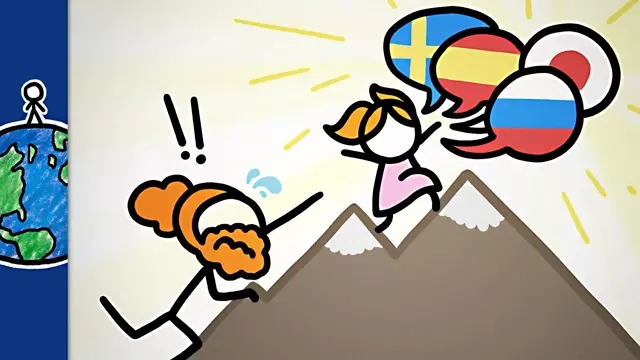2019-10-22
[public] 457K views, 15.8K likes, dislikes audio only
Thanks to the University of Minnesota for sponsoring this video! http://twin-cities.umn.edu/
Learning a new language as an adult is harder than doing so as a child because adults usually aren’t as invested and often use the wrong strategies.
Thanks also to our Patreon patrons https://www.patreon.com/MinuteEarth and our YouTube members.
___________________________________________
To learn more, start your googling with these keywords:
Second-Language Acquisition: The process of a language that’s not the speaker’s native language.
Bilingualism: The ability to speak and understand two languages.
Monitor Model: A group of hypotheses that propose that linguistic competence is only advanced when language is subconsciously acquired.
Sociolinguistics: The study of language in relation to all sorts of social factors.
Linguistic Investment: A motivation to learn a language based on the understanding that the speaker will acquire a wider range of symbolic and material resources, which will in turn increase the value of their cultural capital and social power.
Hyperpolyglot: A person who can speak and understand more than six languages.
___________________________________________
Subscribe to MinuteEarth on YouTube: http://goo.gl/EpIDGd
Support us on Patreon: https://goo.gl/ZVgLQZ
And visit our website: https://www.minuteearth.com/
Say hello on Facebook: http://goo.gl/FpAvo6
And Twitter: http://goo.gl/Y1aWVC
And download our videos on itunes: https://goo.gl/sfwS6n
___________________________________________
Credits (and Twitter handles):
Script Writer, Editor and Video Editor and Narrator: David Goldenberg (@dgoldenberg)
Video Illustrator: Arcadi Garcia Rius (@garirius)
With Contributions From: Henry Reich, Alex Reich, Kate Yoshida, Ever Salazar, Peter Reich, Julián Gómez, Sarah Berman
Music by: Nathaniel Schroeder: http://www.soundcloud.com/drschroeder
___________________________________________
References:
Hartshorne, J., Tenenbaum, J., and Pinker, S. (2018). A critical period for second language acquisition: Evidence from 2/3 million English speakers. Cognition. 177: 263-277. Retrieved from: https://www.sciencedirect.com/science/article/pii/S0010027718300994
Bigelow, M., and Tarone, E. (2004). The Role of Literacy Level in Second Language Acquisition: Doesn't Who We Study Determine What We Know? TESOL Quarterly. 38(4): 689-700. Retrieved from: https://www.jstor.org/stable/3588285?seq=1#page_scan_tab_contents
Darvin, R. and Norton, B. (2015). Identity and a Model of Investment in Applied Linguistics. Annual Review of Applied Linguistics. 35: 36-56. Retrieved from: https://www.cambridge.org/core/journals/annual-review-of-applied-linguistics/article/identity-and-a-model-of-investment-in-applied-linguistics/91EE4C7572272B233A16286768E0E5B8.
Pierce, B. (2015). Social Identity, Investment, and Language Learning. TESOL Quarterly. 29(1): 9-31. Retrieved from: https://www.jstor.org/stable/3587803?seq=1#page_scan_tab_contents.
Derakshan, A. (2015). The Interference of First Language and Second Language Acquisition. Theory and Practice in Language Studies. 5(10):2112-211. Retrieved from: https://www.researchgate.net/publication/283524046_The_Interference_of_First_Language_and_Second_Language_Acquisition.
Rao, P., and Knaus, E. (2008). Evolution of Nonsteroidal Anti-Inflammatory Drugs (NSAIDs): Cyclooxygenase (COX) Inhibition and Beyond. Journal of Pharmaceutical Science. 11 (2): 81-110. Retrieved from: https://www.ncbi.nlm.nih.gov/pubmed/19203472.
Bigelow, M. (2019). Personal Communication. Department of Curriculum and Instruction. University of Minnesota.
Paesani, K. (2019). Personal Communication. The Center for Advanced Research on Language Acquisition. University of Minnesota.
https://www.patreon.com/minuteearth
/youtube/video/gTgbDXYG_OY?t=24
/youtube/video/gTgbDXYG_OY?t=75
/youtube/video/gTgbDXYG_OY?t=105
/youtube/channel/UCeiYXex_fwgYDonaTcSIk6w
https://patreon.com/minuteearth
/youtube/video/4DF94Wvtekk

